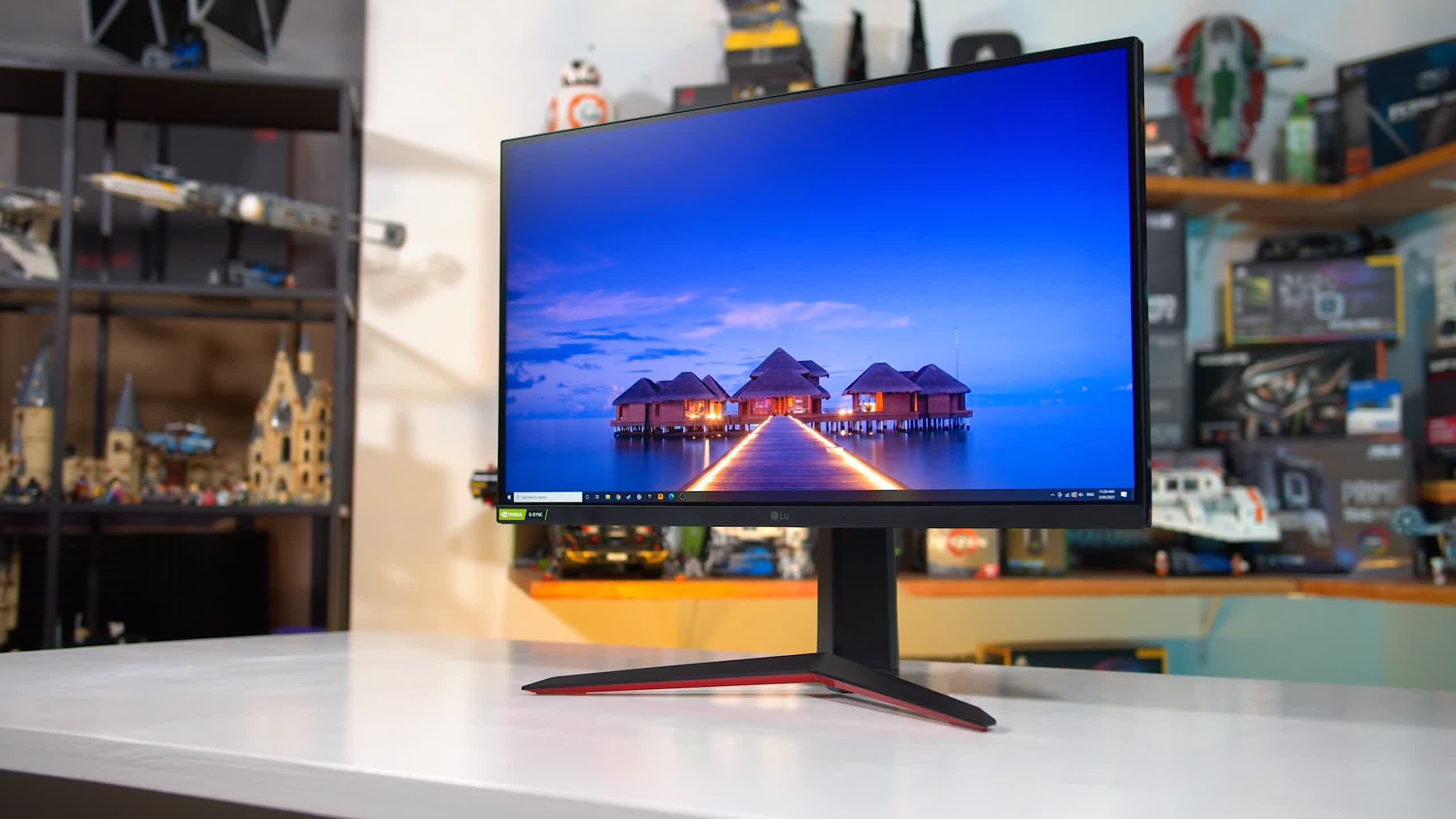See our latest update to this buying guide: The Best Gaming Monitors
For a variety of good reasons, 1440p remains the most popular category of gaming monitors. In case you missed it earlier, we have additional coverage looking at the best monitors overall for productivity and enthusiasts, as well as a selection of the best gaming monitors for those of you wanting 4K resolution, ultrawides or a super-fast 1080p display.
But this article is solely dedicated at 1440p options which we've split in five categories: we've got 1440p medium refresh rate monitors – around the 144Hz mark. Then we'll talk about the high refresh rate 240Hz options. Another section is dedicated to 32-inch monitors as there have been a number of solid new additions there. The fourth category will cover budget friendly 1440p displays, and finally we'll round things off with a discussion about HDR.
We should note, we can't test absolutely everything that's available on the market but since we have tested a ton of these, we're primarily discussing those monitors we have personally tested and know to be of top quality.
Best 1440p 144Hz Gaming Monitor
LG 27GP850 27" Ultragear Nano IPS
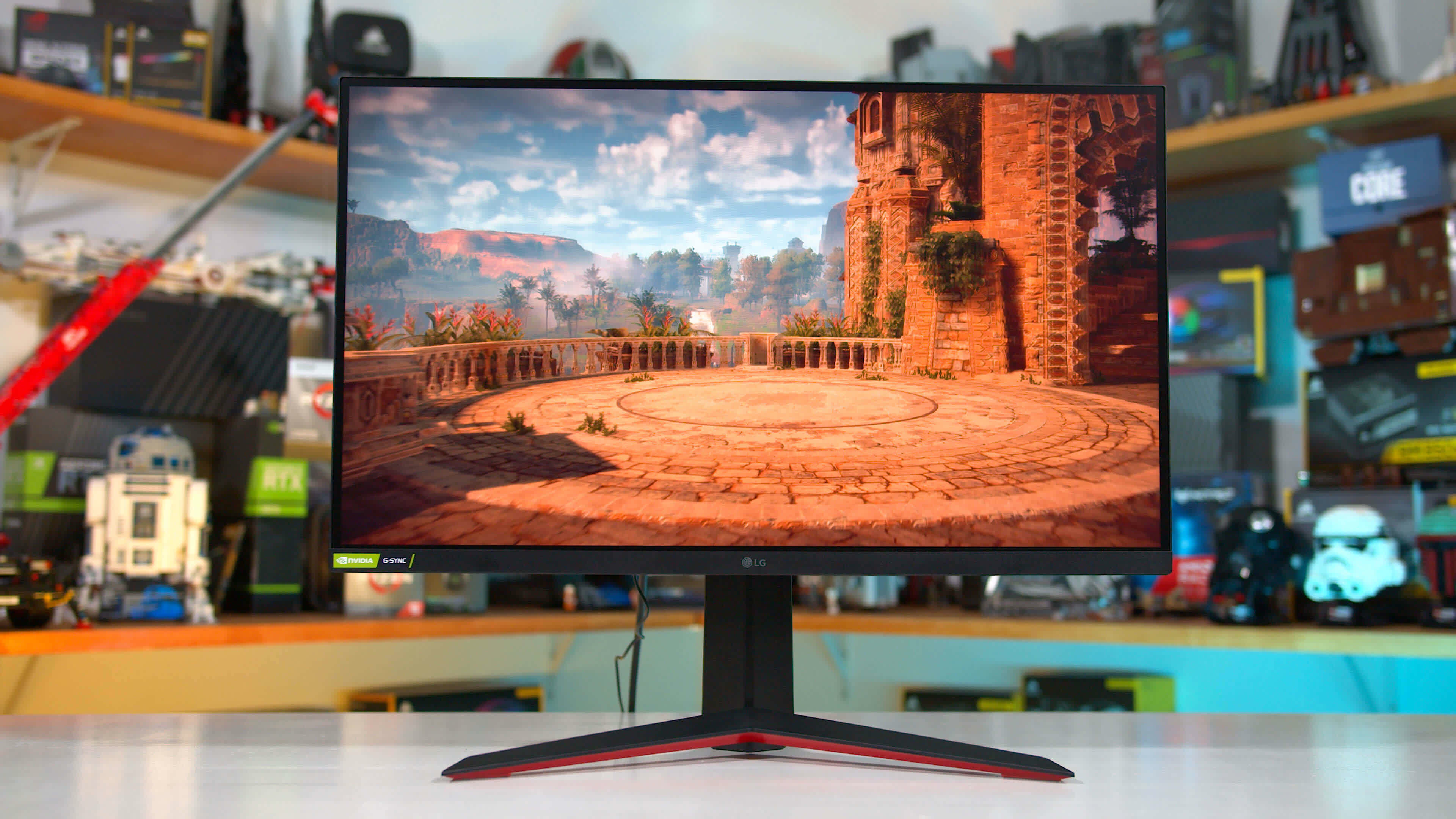
A few short years ago, we'd be discussing 1440p 144Hz displays as "high refresh rate" monitors, but with new 240Hz options out there, that's not truly accurate anymore. Of course, 144Hz is still far superior to the 60Hz monitors of old, and if you've never tried something with this sort of refresh rate, it's well worth an upgrade.
Today's 144Hz displays don't usually top out at just 144Hz, with most of the best options giving you 165Hz, or even 180Hz, along with full adaptive sync variable refresh rate support for all GPUs. For this reason, we are not focusing heavily on "G-Sync" or "FreeSync" branding as realistically all of these monitors work perfectly with variable refresh rate support on both Nvidia and AMD GPUs.
If you're after the best 1440p 144Hz-class display on the market, you'll need to fork out $400 to $500, which is less than on previous years – always nice to see things getting cheaper over time. You'll also be looking exclusively at IPS displays, as neither TN nor VA is particularly competitive in this category, either in overall performance or value. The wide range of high quality IPS options today keeps nudging things further along with each release.
Our two top picks in this category are the LG 27GP850 (read our full review), or the MSI MAG274QRF-QD. The LG is typically priced around $450, while the MSI model is around $420, and they both have different strengths and weaknesses, which is why I didn't side with either as the absolute best, but I think between these two displays you'll find what you are looking for.
The LG 27GP850 uses a Nano IPS panel with updated overdrive optimization to squeeze the most out of this technology. It's a 27-inch 1440p display with a maximum 180Hz refresh rate, accessible through the built-in overclocking feature, and a wide color gamut, around 96% DCI-P3 in our testing. It's the successor to the highly popular LG 27GL850 and is improved in many ways.
The major strength to the 27GP850 is response times. This is one of the fastest monitors in its class, with an impressive 4.7ms average response at 180Hz, and 4.6ms across the refresh range. It delivers a good single overdrive mode experience and LG are pushing the panel right up to its limits, with virtually no visible overshoot artefacts using optimal settings. It also includes a functional sRGB mode, so despite having wide support of DCI-P3, you don't have to suffer through oversaturation while watching standard content like YouTube videos, so you get this nice balance of performance in games, along with color accuracy.
I also like this display's build quality, viewing angles, decent brightness and low input latency. However the contrast ratio is poor, so it wouldn't be my first choice for a monitor to use in darker gaming conditions under dim lights. Also consider the LG 27GP83B which is a $50 cheaper version of the 27GP850 without some features, like the USB hub, 180Hz OC and backlight strobing.
The MSI MAG274QRF-QD is a similar monitor in many ways: a 27-inch 1440p option with a 165Hz maximum refresh rate and 97% DCI-P3 coverage. The difference between 180Hz and 165Hz is negligible in my opinion. However it uses a different AU Optronics panel which may be better suited to your use case.

Unlike the 27GP850, the MSI model has decent contrast for an IPS panel, 28% higher than the LG's. It has an even wider color gamut, supporting 99% of the Adobe RGB color space in addition to great DCI-P3 coverage, which makes it more versatile for content creators, especially if you can calibrate it. And for gamers, MSI offers better backlight strobing with a clearer result and no artifacts like red fringing, which makes it better suited for competitive gaming.
What the MAG274QRF-QD lacks in comparison to the LG model is a functional sRGB mode, so calibrating this display using an ICC profile is a must, and even then not every aspect to this display's oversaturation when viewing sRGB content is fixable. It's also somewhat slower in terms of raw response time, though it's still competitive and offers a single overdrive mode experience, minimizing the need to fumble around in the OSD. Either way you go, you'll end up with a very solid monitor and with pricing so close, there's no clear winner in terms of value. Do the research on what is available in your region and go from there.
Best 1440p 240Hz Gaming Monitor
Samsung Odyssey G7
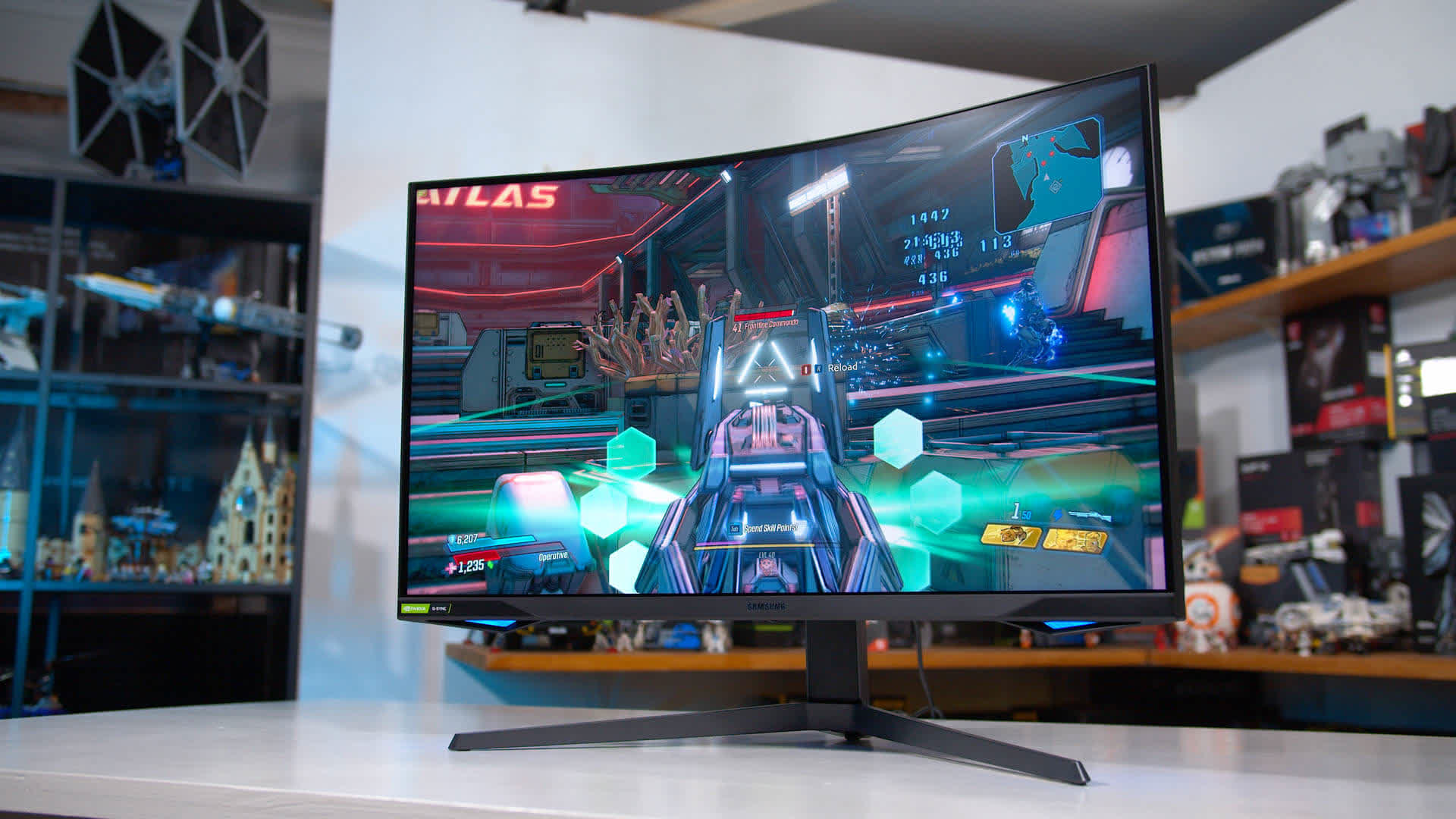
If you want the best of the best at 1440p, you should be aiming for a 240Hz gaming monitor instead. A good number of products have been released in the last 18 months and they should all offer great longevity and future proofing. Granted, they're more expensive than medium refresh rate options above, starting at around $650 for worthy options.
The Samsung Odyssey G7 in its 27-inch variant for $700 (discounted to $499 as of writing), has the fastest response times we've ever tested on a 1440p monitor, which combined with its 240Hz refresh rate and variable overdrive leads to excellent motion clarity - not just at 240Hz, but across the entire refresh range. Then, because it's a VA panel, it also has great black levels and a high contrast ratio, making it well suited for gaming in a dark environment. Color quality is generally impressive as a result, including a decent wide gamut.
The main downside to the Odyssey G7 is its aggressive 1000R curve, which is a divisive feature, you tend to either love or hate it, and I'm more in the hate it camp. The curve limits its versatility - the Odyssey G7 is really only well suited for gaming; content creation and productivity suffers from curve-related distortion, the wide color gamut isn't as wide as other options, and uniformity can be mixed.
How about IPS high refresh options?

If those downsides sound annoying to you, choosing an IPS panel instead might be the way to go. It will be more versatile and perform very well. We've been recommending the Asus ROG Strix PG279QM for a while, which is a truly excellent monitor with class-leading IPS performance and outstanding factory calibration. However, at $900 we do feel it's a bit expensive when a similar alternative, the Acer XB273UGX exists at just $650. We haven't tested this Acer monitor yet, but it appears to use the same panel and performance by all reports is still excellent. So that's one to consider for sure.
Editor's note: We have a dedicated buying guide for the Best Gaming Monitors where we detail more options for 1440p and 4K gaming at different price segments, discuss esports, ultrawide gaming and budget options.
Over the past year, 1440p 240Hz monitors have come into their own with many options available. We don't just have TN options anymore. Samsung's Odyssey G7 gives us an excellent experience using a VA panel, while there are many new IPS options that also offer great gaming performance in this new high refresh rate category.
For pure gamers, the Samsung Odyssey G7 is an extremely compelling option. Samsung's latest generation VA panels are mighty impressive, with class leading response time numbers. This display's peak performance at 240Hz is 22% faster than any IPS alternative we've tested, and thanks to variable overdrive, it maintains excellent results at any refresh rate you throw at it. Overshoot is kept to a minimum and despite being a VA panel, dark level smearing is a non-issue. Throw in backlight strobing, and Samsung comfortably leads the pack in motion clarity while gaming.
The Odyssey G7 is also an outstanding choice for gamers that play in the dark. The VA panel delivers a contrast ratio at least double that of IPS competitors, which helps deliver richer blacks and better shadows. This is complemented by low input lag and a decent build quality - just make sure you update to the latest firmware when you get it to resolve any flickering concerns.
The main drawback to the Odyssey G7 is its versatility. While not a bad monitor for image quality, this display has a smaller gamut than its competitors, with an average DCI-P3 coverage of 89% and no working sRGB emulation mode. The aggressively curved 1000R panel isn't for everyone, hurts viewing angles and can distort the image, which makes this display a poor choice for content creation. But for gamers, the Odyssey G7 is a great choice and it's available in two sizes: 27" for $700 and 32" for $800, which is pretty fair for what it offers.
Better for Creators
If you need a better balance between gaming and image quality, you should consider an IPS monitor instead. The Asus ROG Swift PG279QM is a 27-inch 1440p flat IPS monitor that used a new AU Optronics panel that tops out at 240Hz. The feature set Asus offers is second to none and in my opinion this is an excellent alternative.
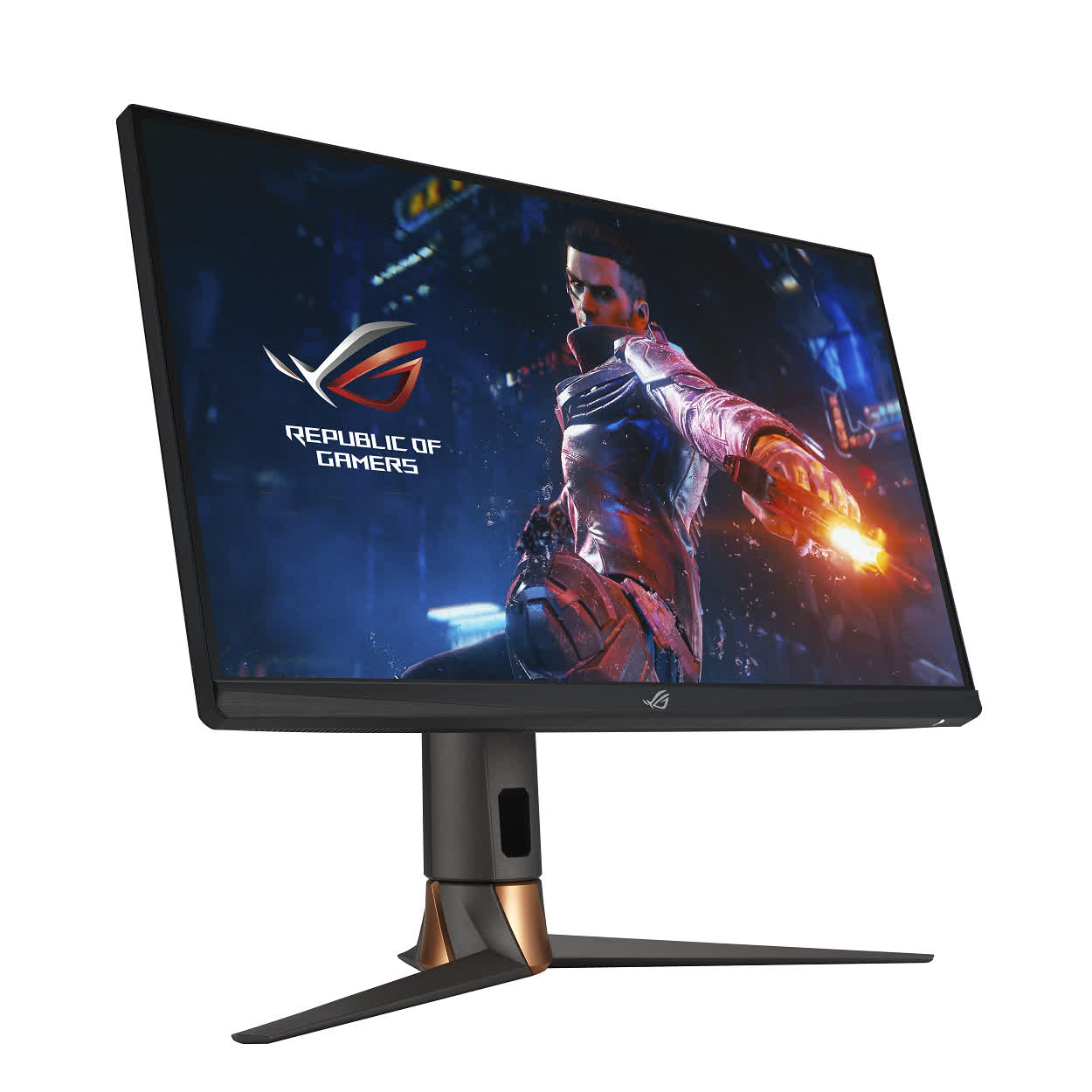
The PG279QM isn't as fast as the Odyssey G7 in terms of response times, but it's among the fastest IPS monitors we've tested with excellent motion clarity. Unfortunately, there is no backlight strobing support, however it balances this with outstanding color quality, probably the best mixture of features and performance I have ever seen.
This is an extremely wide gamut monitor, with 96% DCI-P3 coverage, 100% Adobe RGB coverage and over 80% Rec. 2020 in total, the widest you can get from an LCD gaming monitor today. But it also features an elite implementation of an sRGB mode, reducing oversaturation when viewing standard content completely, and helping to deliver well above average factory calibration, unmatched by its rivals. It also uses a flat panel with excellent viewing angles, making it well suited to creative and productivity work without distortion.
The PG279QM is hard to find, it's often out of stock although it is a relatively new product, and it is expensive: $850, which is $150 more than the same size Odyssey G7. It's a great monitor but it's one of those cases you have to pay for the best.
Another alternative that is more readily available is the Alienware AW2721D which uses an LG Nano IPS panel. It performs very well, certainly befitting of a high end product, but it is a step down from the Asus in most regards, whether we're talking response, color accuracy or wide gamut support; though it does have a better contrast ratio. The AW2721D isn't much cheaper in the US, usually going for $825, but in other regions like Australia, you can find it for ~$600, which is a more compelling offer.
Best 32-inch 1440p Gaming Monitor
Asus ROG Swift PG329Q 32"
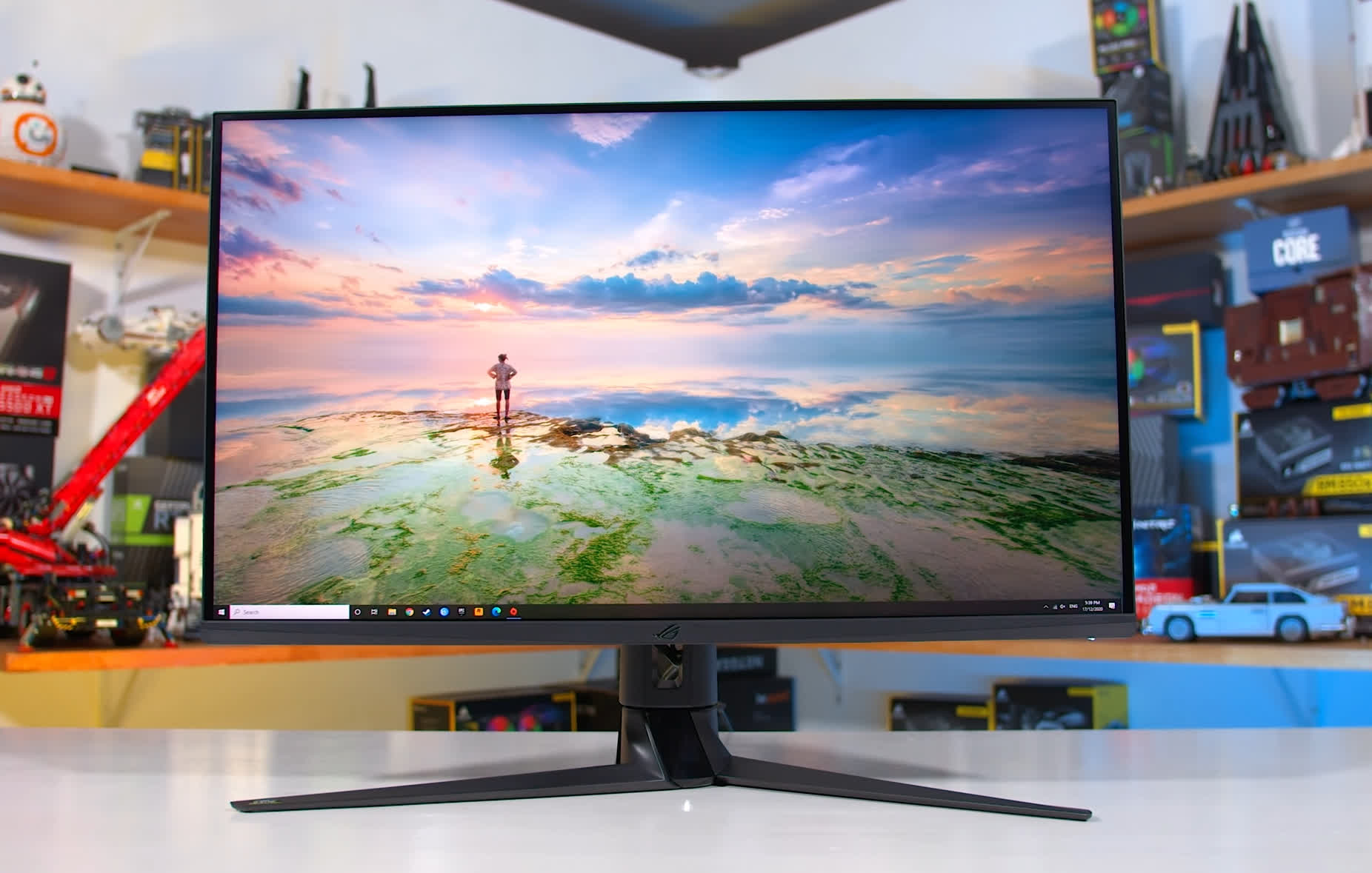
The 32-inch 1440p category has received a ton of new options in the past year as high-end IPS models have entered the market. Just a couple of years ago, if you wanted a 32-inch 1440p monitor with a decent refresh rate for gaming, your only set of options were VA panels with okay performance and with issues like dark level smearing. That is no longer the case.
One of the top options to consider in this larger size class is the Samsung Odyssey G7, which we just talked about in the 240Hz section, so we won't repeat ourselves here, but essentially if you want a 32-inch 1440p 240Hz monitor, then your only choice is the Odyssey G7 as IPS panels haven't reached those refresh rates yet. But that's not a bad thing, as the Odyssey is an excellent product that's well worth buying as a flagship product with future proof specifications. But if you don't want to spend $800, but still want a larger 32-inch monitor for gaming - or you'd rather something with an IPS panel - there are many options to choose from.
The best of the bunch is the Asus ROG Swift PG329Q, which uses an AU Optronics panel. It's a 32-inch 1440p 175Hz display that offers excellent performance in most areas. Response times average below 5ms leading to great motion clarity at 175Hz, and performance holds up very well across the refresh range thanks to the inclusion of variable overdrive. Asus complements this single overdrive mode experience with backlight strobing that delivers a clear image, and it even works with adaptive sync enabled, though not always with the best results compared to a static refresh rate.
We also get all the image quality benefits of AU Optronics' latest generation IPS panels. An extremely wide color gamut headlines the feature list, along with great viewing angles and good uniformity. Unfortunately, Asus didn't nail the sRGB mode, although it does exist, so some level of calibration is required for the best results. Contrast is also average, so it's not as good of an option for gaming in dark environments as the Samsung Odyssey G7. But on the balance of features and performance, the PG329Q is a great option with a lot of versatility.
The Asus PG329Q is often hard to find, but is slightly cheaper than the Odyssey G7 at $700 and is in our opinion the best 32-inch 1440p IPS monitor available right now.
For more budget conscious shoppers, the Gigabyte's M32Q is very similar on the spec sheet to the Asus, with a 32-inch 1440p 170Hz IPS offering, however it uses an Innolux panel which can't quite match the AU Optronics in performance and therefore is more affordable. The M32Q still performs well and offers excellent bang for buck.
Response time performance at the highest refresh rate isn't that far behind the PG329Q, it just lacks variable overdrive, so isn't as good across the entire refresh range and doesn't have a single overdrive mode experience. It also doesn't have as wide of a gamut, though is better factory calibrated and has a superior sRGB mode. Image quality is good and a contrast ratio of 1100:1 beats the Asus monitor for black levels.
The key selling point is a price tag of just $500, considerably less than the PG329Q or Odyssey G7. It can also be found on sale occasionally below that price, further strengthening its value. Personally, I would choose it over the similar LG 32GP850, which tends to be $50 to $100 more expensive for similar performance, though you should assess pricing in your region as these can vary.
Best Budget 1440p for Gaming
Gigabyte M27Q 27"
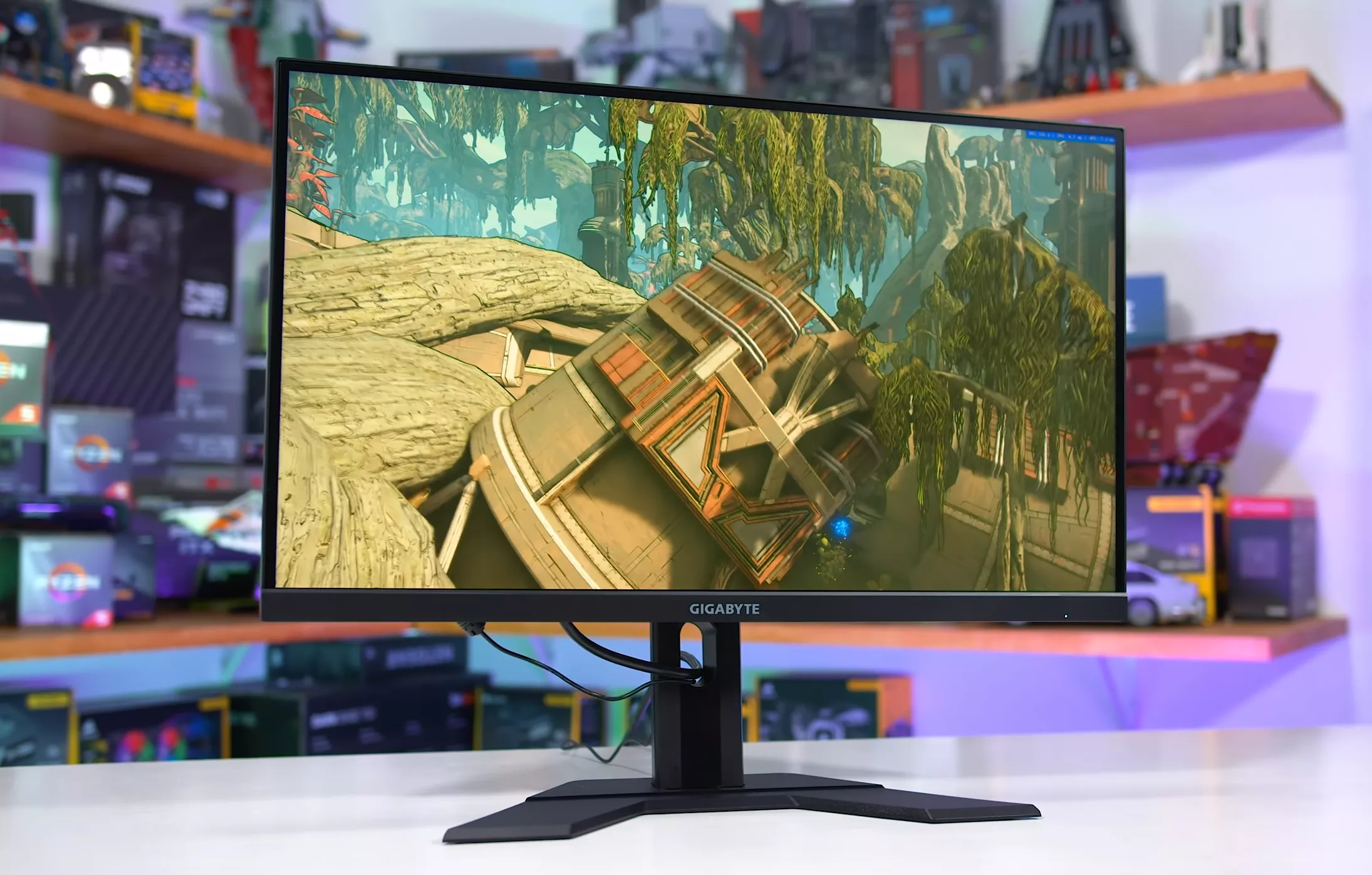
The best budget 1440p monitor right now is the Gigabyte M27Q. Typically retailing for a bit over $300, the M27Q offers excellent value and bang for buck in the 1440p category, it's got a 170Hz IPS panel, and includes useful feature additions like a KVM switch.
The Gigabyte M27Q delivers decent mid-range response time performance, a wide color gamut with an sRGB mode, great ergonomics thanks to a height adjustable stand, fantastic viewing angles, and solid contrast for an IPS. It delivers an excellent mix of gaming performance and color quality at this price point, outperforming many other mid-range displays, which are often more expensive. It's hard to go wrong with this display and the price continues to be aggressive for what you get.
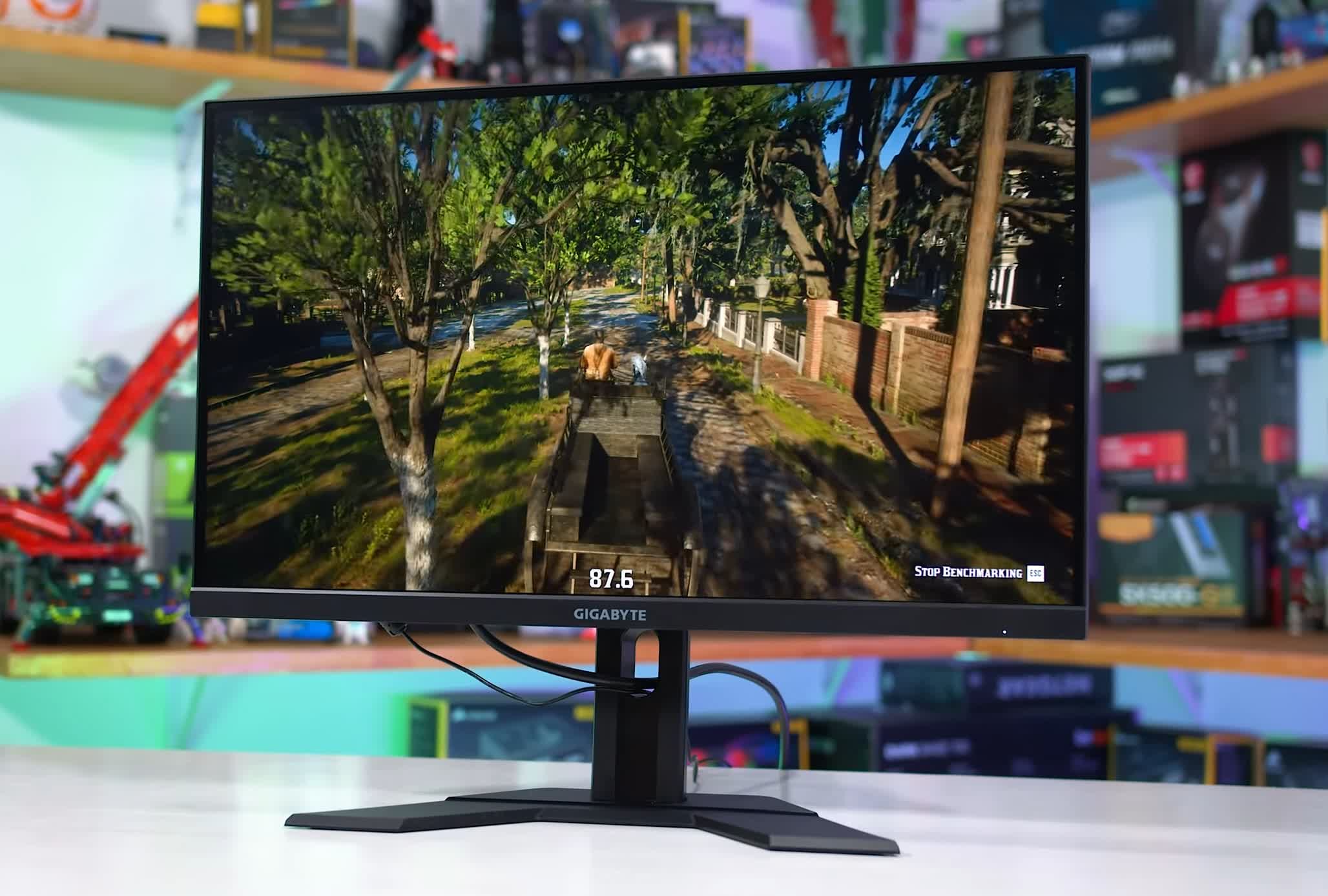
The main downside to this monitor is the use of an IPS panel with a BGR subpixel layout instead of the conventional RGB layout. This has a small effect on text clarity in some use cases, although we've personally found it to only be a minor issue in Windows applications after a run through with the ClearType utility. We'd recommend it regardless of this issue, or alternatively the Gigabyte G27Q might be worth considering at a similar price. We'd also look at the MSI Optix G273QF as an alternate option, though we haven't tested it and it's more expensive.
Between the M27Q and MAG274QRF-QD (our top 1440p 144hz pick) you have two excellent options at two distinct price points: a cheaper, bang for buck option for budget shoppers; and a more premium product that also doesn't break the bank.
Dell and LG options
Several other monitors were up for consideration in this category. In the past we've recommended the Dell S2721DGF as an option, and it's still great value today at $330. The Dell monitor is a bit faster on average, has a wider color gamut and a normal RGB subpixel layout, but it has a terrible contrast ratio, doesn't include an sRGB mode at all, so it's prone to oversaturation, and lacks the KVM switch.
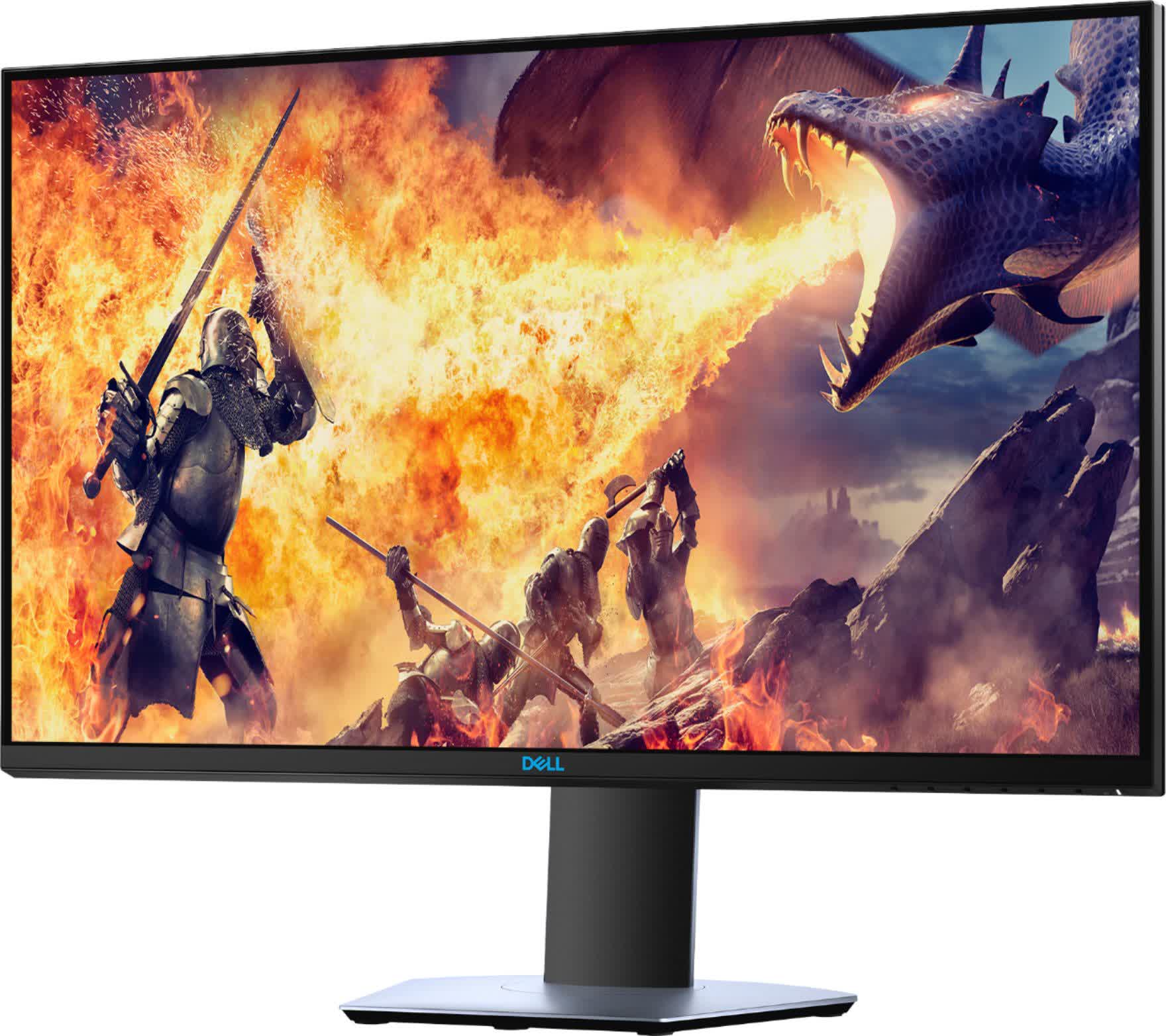
It's a similar story with the LG 27GP83B, which is a slightly better but also more expensive version of the S2721DGF. Most monitors that use LG's Nano IPS panels aren't competitive enough with the M27Q, and begin approaching the price of the MAG274QRF-QD which is simply better.
Going Cheaper with VA?
The price floor for 1440p IPS monitors with a 144Hz refresh rate is approximately $300, so what are the options below that? That's where we get into VA monitor territory, and we honestly would not spend more than $300 on a budget or mid-range VA as they get smoked in response time performance by the M27Q and better IPS displays.
Aside from the Samsung Odyssey G7, other VA panels are simply not competitive at higher price tiers where IPS is dominant. But VA does have its place in the market. If you only have $250 to spend, then your options are either a budget curved 1440p 144Hz VA, or a 1080p 144Hz IPS and for a lot of people the resolution difference makes the 1080p option a no-go. You'll have to deal with VA's dark level smearing, inferior response times, worse viewing angles, less expansive color gamuts, and the abundance of curved panels – but as an entry level option, we still think they are reasonably good.
Response time performance is often not too far away from budget IPS monitors, the difference mostly amounts to dark level smearing. You still get better viewing angles than TN monitors, excellent contrast ratios, which are great for gaming in dark environments, and decent color quality overall. Most budget VAs use a variation of the same Samsung VA panels, so the differences in performance between them are small. The Samsung Odyssey G5 and AOC CQ27G2 are two options we'd be looking at, provided you can get them for $260 or less.
Best 1440p HDR for Gaming
If you're after a 1440p gaming monitor with true HDR functionality, stop your search now, because they don't exist. There isn't a single 1440p monitor on the market that uses OLED technology, or is an LCD with a full array local dimming backlight, which means that no current 1440p monitor is able to offer an adequate contrast ratio to properly reproduce HDR content.
The majority of "HDR capable" 1440p monitors are not really HDR capable at all, outside of supporting HDR inputs. Most DisplayHDR 400 monitors, or worse, those without any DisplayHDR certification, fail on multiple fronts. Their contrast ratio is too low as they don't have adequate local dimming, meaning that bright and dark areas cannot properly be displayed on the screen at the same time, defeating the entire purpose of HDR.
Most of these monitors don't get bright enough either, and some don't have a wide enough color gamut. The easiest way to think of DisplayHDR 400 monitors is that they are not HDR, and should be considered SDR-only. In fact, these monitors often look worse in their HDR mode than displaying good old SDR, as zero effort goes into optimizing the HDR experience and getting it to look accurate.
There are some displays that are slightly better. We tend to call these "semi-HDR" displays. Usually these are DisplayHDR 600 certified or better, with edge lit local dimming and brightness that exceeds 600 nits. While a good quality monitor with edge lit dimming can, in some circumstances, deliver image quality better than regular SDR in their HDR mode, the overall HDR experience is poor relative to "true" HDR displays that deliver dazzling brightness and very high contrast.
We don't believe it's worth paying for poor HDR, so our advice is to buy the best SDR monitor and if you get something semi-HDR then it's a bonus. Examples of semi-HDR monitors with edge lit dimming include the Samsung Odyssey G7, Asus PG329Q and Alienware AW2721D, and of that bunch the Odyssey G7 offers the best quality HDR, but it's still several notches away from meeting the minimum standard for true HDR.
For a true HDR experience, your options are to buy an expensive 4K LCD with full array local dimming - usually costing you thousands - or grab a decent OLED or mini-LED TV.
